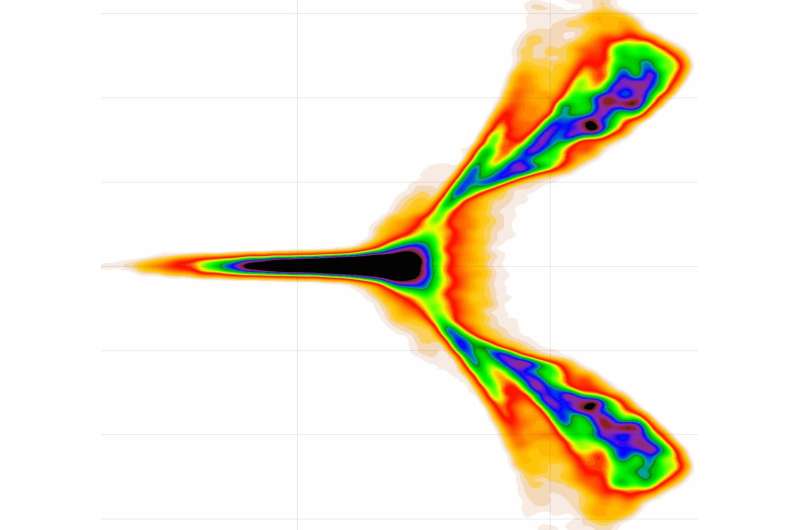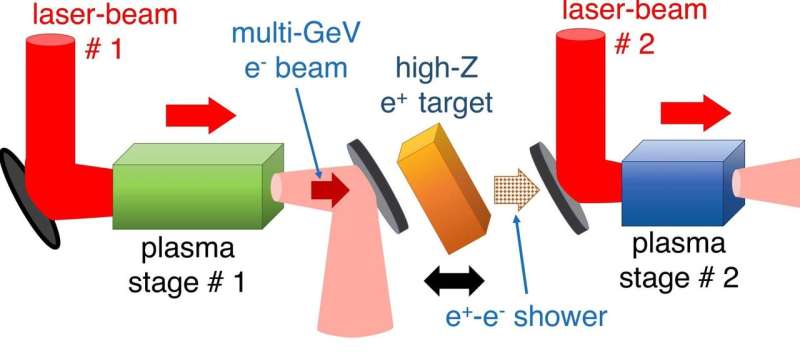Mini antimatter accelerator could rival the likes of the Large Hadron Collider

Researchers have found a way to accelerate antimatter in a 1000x smaller space than current accelerators, boosting the science of exotic particles.
The new method could be used to probe more mysteries of physics, like the properties of the Higgs boson and the nature of dark matter and dark energy, and provide more sensitive testing of aircraft and computer chips.
The method has been modelled using the properties of existing lasers, with experiments planned soon. If proven, the technology could allow many more labs around the world to conduct antimatter acceleration experiments.
Particle accelerators in facilities such as the Large Hadron Collider (LHC) in CERN and the Linac Coherent Light Source (LCLS) at Stanford University in the United States, speed up elementary particles like protons and electrons.
These accelerated particles can be smashed together, as in the LHC, to produce particles that are more elementary, like the Higgs boson, which gives all other particles mass.
They can also be used to generate X-ray laser light, such as in the LCLS, which is used to image extremely fast and small process, like photosynthesis.
However, to get to these high speeds, the accelerators need to use equipment that is at least two kilometres long. Previously, researchers at Imperial College London had invented a system that could accelerate electrons using equipment only meters long.
Now a researcher at Imperial has invented a method of accelerating the antimatter version of electrons—called positrons—in a system that would be just centimetres long.
The accelerator would require a type of laser system that currently covers around 25 square metres, but that is already present in many physics labs.Dr. Aakash Sahai, from the Department of Physics at Imperial reported his method today in the Physical Review Journal for Accelerators and Beams.

He said: "With this new accelerator method, we could drastically reduce the size and the cost of antimatter acceleration. What is now only possible by using large physics facilities at tens of million-dollar costs could soon be possible in ordinary physics labs."
"The technologies used in facilities like the Large Hadron Collider or the Linac Coherent Light Source have not undergone significant advances since their invention in the 1950s. They are expensive to run, and it may be that we will soon have all we can get out of them.
"A new generation of compact, energetic and cheap accelerators of elusive particles would allow us to probe new physics—and allow many more labs worldwide to join the effort."
Creating 'Higgs factories' and testing aircraft
While the method is currently undergoing experimental validation, Dr. Sahai is confident it will be possible to produce a working prototype within a couple of years, based on the Department's previous experience creating electron beams using a similar method.
The method uses lasers and plasma—a gas of charged particles—to produce, concentrate positrons and accelerate them to create a beam. This centimetre-scale accelerator could use existing lasers to accelerate positron beams with tens of millions of particles to the same energy as reached over two kilometres at the Stanford accelerator.
Colliding electron and positron beams could have implications in fundamental physics. For example, they could create a higher rate of Higgs bosons than the LHC can, allowing physicists to better study its properties. They could also be used to look for new particles thought to exist in a theory called 'supersymmetry', which would fill in some gaps in the Standard Model of particle physics.
The positron beams would also have practical applications. Currently, when checking for faults and fracture risks in materials such as aircraft bodies, engine blades and computer chips, x-rays or electron beams are used. Positrons interact in a different way with these materials than x-rays and electrons, providing another dimension to the quality control process.
Dr. Sahai added: "It is particularly gratifying to do this work at Imperial, where our lab's namesake—Professor Patrick Blackett—won a Nobel Prize for his invention of methods to track exotic particles like antimatter. Professor Abdus Salam, another Imperial academic, also won a Nobel Prize for the validation of his theory of weak force made possible only using a pre-LHC positron-electron collider machine at CERN. It's wonderful to attempt to carry on this legacy."
More information: Aakash A. Sahai, Quasimonoenergetic laser plasma positron accelerator using particle-shower plasma-wave interactions, Physical Review Accelerators and Beams (2018). DOI: 10.1103/PhysRevAccelBeams.21.081301
Provided by Imperial College London





















